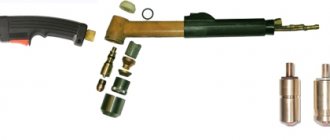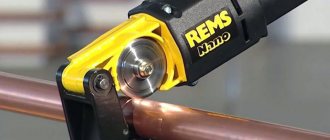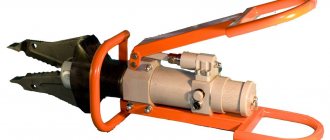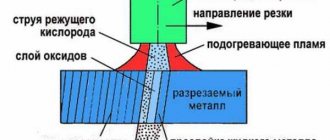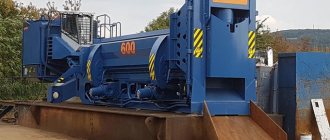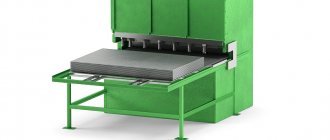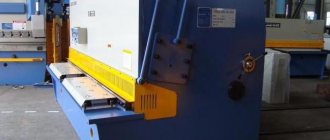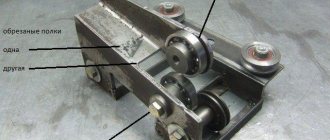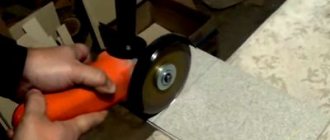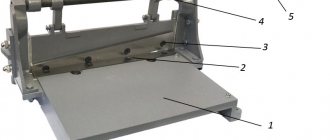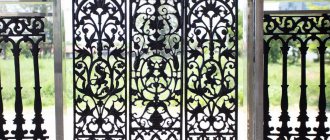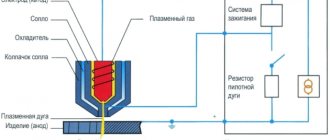Machine-building and metalworking enterprises produce a wide range of metal products and structures, the manufacturing technology of which requires cutting profile and sheet metal. Sometimes even owners of home workshops, as well as workers at a construction site, have to perform this mandatory operation. To quickly and efficiently cut metal, you need to have the right equipment on hand. One of the most popular are guillotine shears, which today are available in several versions.
It is often necessary to cut metal using a guillotine when the owner of a home workshop or a worker at an industrial enterprise is faced with the task of producing large rectilinear parts - triangles, rectangles and strips with sides ranging from several centimeters to several meters. To obtain the required workpiece, it is necessary to process rolled metal with a thickness of 2 to 60 mm, a width of up to 2 meters and an almost unlimited length.
Purpose
The cutting machine allows you to cut workpieces up to 35 mm thick. However, each type has its own technical parameters. The manual guillotine is capable of cutting metal up to 3 mm thick. Cutting on machines can be performed in different directions.
The equipment processes blanks of sheet profiles, as well as round, angular and square sections. A special feature when working on these machines is accuracy, prevention of possible defects, as well as preservation of paint coating on metal surfaces.
Construction vacancies
Guillotines , i.e. guillotine or sheet shears are used for fast and high-quality cutting of metal. The name of these metal-cutting machines comes from the similarity of the work of knives with a medieval execution instrument. Nowadays, guillotines for metal, or as they are also called, guillotine shears , are used for harmless purposes; they are in demand at all metalworking enterprises and allow for fast and high-quality cutting of metal. Guillotine , or guillotine shears , is a device that is used for cutting and cutting metal sheets of different thicknesses in both longitudinal and transverse directions with a high level of accuracy. Some types of guillotines are capable of cutting round, square or angular rolled metal. The use of a guillotine allows you to obtain an accurate cut without dents or nicks, while guillotine shears do not damage the polymer coating of the metal or its painting. Depending on the technical capabilities, guillotine shears are used both in individual and mass production.
So, the main criteria for choosing a guillotine are the type of production: mass, serial or piece, as well as the length of the cut, the thickness of the sheet being cut, its overall dimensions and mechanical strength. The technical needs of metalworking enterprises, depending on their level and capabilities, can be satisfied by both simple manual guillotines and more complex electromechanical or hydraulic guillotine . Basically, many models of guillotines , in addition to manual ones, can be equipped to varying degrees with industrial electronics and additional options that increase their productivity. Despite the variety of drive types, the operating principle of all guillotine is the same and consists of the following basic operations: - placing the sheet to be cut on the guillotine along the set stops between the upper and lower knives; — preliminary pressing of the sheet to the guillotine table using a pressure beam; — moving the upper knife, cutting; — transportation of finished parts from the cutting zone. The cutting accuracy of guillotine shears is ensured by the sheet pressing mechanism. As a rule, cutting is carried out along a stop or marking; precise back rulers are installed on metal guillotines The precision and accuracy of the cut without burrs or crushing of the edge is highly valued. Some guillotine are also equipped with a return tray where the cut metal is collected. The main characteristics of a guillotine used for cutting metal are: • Cut length. As a rule, it is up to 2.5 meters. • Maximum cutting thickness. Determined by steel with a hardness of 400/mm2.
guillotine models produced today can satisfy the needs of metalworking enterprises of various levels and capabilities.
According to the design principle, the guillotine can be: manual, pneumatic, hydraulic, mechanical, automatic (CNC), and also combine several combinations. guillotines are the simplest type and are used for straight cutting of metal sheets, rubber, cardboard, etc. The hydraulic guillotine with an electromechanical drive is characterized by ease of operation and high labor productivity, and the adjustment of the position of the knives ensures cutting accuracy. guillotine shears with manual or automatic adjustment of the gap between the knives are very popular This type of guillotine is easy to operate and is used for cutting not only sheet metal, but also rods.
When choosing one or another model of guillotine shears , you need to carefully think through the list of functions that will subsequently be in demand. After all, a large number of them is not always an advantage, while the cost of such a machine is directly dependent on this indicator. a guillotine with a set of necessary functions in small repair shops or in single-unit production. Multifunctional guillotine shears are needed in large industries that require intensive operation, high productivity and precision. We should not forget that such a machine is quite large in size.
Our company specializes in the production and sale of metalworking machines and equipment ; from us you can purchase an assortment of metal guillotines
Design and principle of operation
The metal guillotine has the following device:
- the base frame consists of two pedestals fastened together with a traverse, as well as connecting beams;
- the work table is fixed on the traverse, it is used to install the workpiece on the surface;
- the upper blade is mounted on a movable beam, and the lower blade remains motionless during operation;
- the work table has additional elements for leveling the material and pressing it, as well as a mechanism with which the cutting depth is adjusted.
High-power machines are equipped with a safety device; when the load increases, the pin is cut off, as a result of which the moving part stops moving. Some scissors have a tray installed at the bottom to collect metal scraps. When using a guillotine driven by an electric motor, a gear unit is installed on the traverse.
The principle of operation of the equipment is based on the initial lifting of the blade and its subsequent accelerated descent to the workpiece, the parts are separated. When working on the machine, follow the following algorithm:
- material for cutting is placed on the surface of the work table;
- the workpiece is aligned with the stops, secured, and then the depth of lowering of the cutting blade is adjusted;
- the clamping mechanism ensures high accuracy and also prevents movement of the part;
- when the drive is turned on, torque is transferred to the traverse and it begins to move;
- after the cut, the separated metal elements flow towards the operator or into a storage tray;
- reaching the upper position of the traverse, it blocks the sensor and the engine is switched off.
Limit switches are used to block the upper and lower points. They are installed on the bed, with the help of these devices the electric motor of the machine is turned off and on
Principle of operation
The mechanism of operation of guillotine shears is very simple. The cutting structure itself consists of two parts, of which the lower one is stationary and rigidly fixed to the frame, and the upper one moves in the vertical direction using various types of drives.
This principle of cutting metal was named after the guillotine, which was used in France at the end of the 18th century to cut off the heads of criminals sentenced to death.
The main difference from the European execution instrument and metal processing machine is that the upper working blade is lowered onto the metal plane not only under the force of its own weight, but is necessarily reinforced by an electric or hydraulic drive. The simplest designs of a cutting device are driven by human muscle power.
Specifications
The mechanical guillotine has the following technical characteristics:
- the shape and type of material that can be processed with metal scissors;
- the total number of operations performed on the equipment;
- the magnitude of the load with which the blade acts on the metal;
- dimensional indicators of the workpiece;
- maximum thickness of the metal part;
- number of cuts per minute;
- a type of cutting blade;
- rated power and supply voltage of the electric motor;
- type of gearbox for converting motion.
Varieties
When cutting metal blanks, materials of different shapes and thicknesses are used. To increase the productivity of the operation, the following types of machines are used:
- Manual guillotine scissors. This type of equipment is used in industry; with their help, the operator can cut plexiglass, sheet metal, cardboard, and plastic.
- Hydraulic guillotine shears. With their help, high cutting accuracy is achieved, while metal of maximum thickness is processed. The drive is carried out through the operation of a hydraulic system; the workpiece is secured using clamping cylinders. The gap between the work table and the blade is set manually using a metal ruler.
- Mechanical guillotine shears are considered reliable installations. During operation, a low level of electricity is consumed. The cutting process occurs when the shaft moves from the drive motor.
- Electromechanical equipment has increased efficiency. The mechanism is controlled by a built-in CNC unit.
Guillotine shears are hydraulic, electromechanical and manual
Mechanical guillotine shears are used for straight, transverse or longitudinal cutting of material.
The design of any guillotine shears includes:
— one welded frame on which the working area of the scissors itself is installed,
- one back stop for precision cutting process,
- a table with fixed knives and hydraulic cylinders; on average, the length of the table with scissors can reach up to 3200 mm.
Design and method of operation of guillotine shears
The scissors frame, often welded, consists of a left and right post, which are connected to each other. A table is attached between the posts and has the ability to move to adjust the gap between the movable and stationary guillotine blade.
The movable knives of guillotine shears are attached to a knife shaft, which is driven by a lever mechanism, which is firmly attached to the frame through axles mounted on cylinders in brackets. The knife beam of the guillotine moves vertically along the guides. As usual, guillotine shears have a pressure beam that fixes the workpiece on the table, which is very convenient.
Below are approximate characteristics of the most common guillotine shears.
When manufactured at the enterprise, guillotine knives must undergo special heat treatment to give the material of the scissors increased strength and hardness. For scissors equipped with hydraulics, the most important thing is that they have a durable and heavy body to achieve high cutting accuracy. Knives for units usually consist of meter-long modules, which are made of high-strength steel. There are knives for cutting ordinary metals and especially durable ones.
Knives for guillotine shears with complex geometric profiles are manufactured on numerically controlled machines, this allows achieving the required accuracy and quality of the resulting products. Knives for guillotines are manufactured in factories according to GOST 25306-82
Selection principle
When purchasing a mechanical guillotine, the following factors are taken into account:
- cost of the machine;
- who manufactured the equipment;
- reliability level;
- availability of good reviews online;
- the cutting guillotine must be made of high-quality components;
- service and warranty.
Advantages and disadvantages
Advantages of guillotine shears for metal:
- ease of cutting;
- reduction of energy costs when operating mechanical guillotines;
- cutting occurs without shavings and sawdust, production waste is reduced;
- the workpiece after processing has a smooth edge without chipping;
- cutting accuracy;
- high performance hydraulic guillotine;
- management and control of cutting operations using CNC.
Manufacturers and cost
The cutting guillotine is manufactured in Russia, China, and Turkey. When choosing equipment, it is necessary to take into account the productivity and dimensional characteristics of the machine. The price of a manual guillotine for cutting metal is from 5,000 rubles. The cost of complex equipment is from 500,000 rubles.
Types of guillotine shears
According to the type of drive, guillotine shears are divided into:
- manual;
- hydraulic;
- pneumatic;
- electromechanical;
- combined.
Manual guillotine shears
The manual guillotine is widely used not only in large production, but also in auto repair shops and even home garages. No electricity is needed to operate, and the blades can handle thin metal, plexiglass, plastic, rubber and cardboard. Ideal for solving everyday problems. It is activated by mechanical action on a lever attached to the blade.
Hydraulic shears
Hydraulic shears are common in medium and large factories. High cutting accuracy and adaptability to various sizes of metal have made these scissors quite popular. Large machine-building companies also prefer hydraulic guillotines with the ability to cut metal about 6 meters wide and more than 20 millimeters thick. A force of 500 MPa is applied along the entire length of the sheet. The gap between the knives is adjusted automatically or manually. Sometimes hydraulic shears are equipped with CNC, which facilitates mass production, photo sensors and protective screens.
Pneumatic guillotine
Not a single large-scale production can do without a pneumatic guillotine. For its operation, a compressor or a central line with compressed air is used. High accuracy and speed of work allows us to obtain a certain number of high-quality parts in a short time. The operating principle is similar to hydraulic shears.
Electromechanical shears
The most precise method of cutting metal is achieved using electromechanical guillotine shears. The dimensions of the workpiece are calculated by a built-in computer, and the knife is driven by a motor. Such guillotines are cheaper than hydraulic ones, but consume a large amount of electricity, which is why they are used less often.
DIY making
The DIY design is capable of cutting sheet metal up to 3 mm thick.
Assembling a manual guillotine for metal:
- The size of the structure is determined and a diagram is drawn.
- The forces that will be experienced by different sections of the installation are calculated.
- Afterwards, the parts are printed on a printer and a model of the future manual machine is assembled.
- Selection of material for making scissors. The printed elements act as an example for metal blanks.
- Using abrasive materials, the parts are given a similar shape.
- A manual guillotine consists of a pair of ears, a handle, a frame and a holder.
- Two corners with a gap are installed on the body.
- The handle is attached to the body with a pair of ears.
- Old files can be used as blades; they are processed according to the size of the holding mechanisms.
- Sharpening of knives is carried out after fastening.
- The manufactured mechanism is installed on the working surface of the workbench.
Guillotine shears for metal: types and purpose
When manufacturing various metal structures and products, it is often necessary to perform such an operation as metal cutting. Moreover, to obtain workpieces that correspond to pre-calculated parameters, it is necessary to use a specialized tool, which is guillotine shears. With its help, you can quite accurately and efficiently cut workpieces from various materials - non-ferrous metals and their alloys, as well as steel.
- Purpose and design
- Operating principle
- Types of scissors Hand scissors
- Hydraulic shears
- Pneumatic
- Mechanical machines
- Electromechanical guillotine
Exploitation
When working on a guillotine for cutting metal, you must observe the following precautions:
- the operator should wear protective clothing and shoes; it is recommended to hide hanging objects;
- install protective barriers, do not remove or replace them until the metal cutting process is completed;
- In case of malfunction, it is forbidden to start the scissors; you must inform a specialist;
- if there is dirt, it should be removed;
- working surfaces are cleared of foreign objects;
- The cutting area is equipped with appropriate lighting.
Manufacturers do not recommend exceeding the rated loads on the guillotine elements. The material must be fixed before processing. At the end of the cutting process, the units are wiped and removed from dirt, and the machine is turned off.
